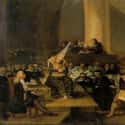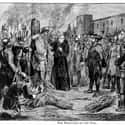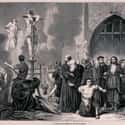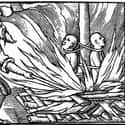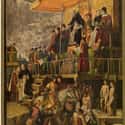(#14) The Accused Had To Wear Special Clothing To Mark And Humiliate Them
As part of the spectacle of the auto de fé, prisoners had to appear in special clothing. Known as the "sanbenito," the garments were a coded yellow tunic that would reveal a prisoner's crimes and fate. They were decorated with symbols and colors. People who were condemned to die wore the Samarra tunic, which had pictures of flames sewn on it. The condemned had to walk through the streets in this garment with a rope around their neck and while carrying a candle. Often, they also wore large pointed hats.
(#4) It Happened All Around The World
The origin of the phrase "auto-da-fé" speaks to where the ritual was developed: it's Portuguese and means "act of faith," as does the Spanish version, "auto de fé." In the early modern world, Portugal and Spain were expanding their global reach and colonizing the so-called "New World." So the Inquisition and autos de fé spread to the Americas where they fit in nicely with Spain's missionary projects in North and South America. Autos de fé sprung up everywhere from Mexico City to Lima. But autos de fé weren't just in the Americas - Goa even had its own Inquisition from 1560 to 1812.
(#3) Torture (Including Having Your Limbs And Head Cut Off) Was Common
Torture was definitely a part of the Inquisition process. Though it was controversial, it was within the rights of Inquisitors to use torture as a way to extract a confession during a trial. But the accused's suffering did not end when the trial did. The auto de fé - the final stage of an Inquisition trial - presented yet another opportunity for torture. If an accused person wasn't burned alive or sentenced to life in prison, a range of other punishments was possible. Some people were whipped and tortured in other brutal ways.
One of the most disturbing sentences happened in 1766, when the 19-year-old François-Jean de la Barre was sentenced to have his tongue and arm cut off before being burnt alive. Though his sentence was ultimately commuted to beheading and burning, it was still an outrage to people like Voltaire, who used the event to criticize the Catholic Church.
(#6) Hundreds Of Thousands Of People Probably Went Through It
It is difficult to estimate the exact number of people who had to suffer through an auto de fé. Enactment of autos de fé varied by location and time. Some autos de fé were larger and more frenzied than others. But historians generally agree that in the heyday of the auto de fé, hundreds of thousands of people had to go through the dangerous, harmful, and humiliating ritual - and only the lucky ones survived.
(#2) Some Of It Involved People Being Burned Alive
Perhaps the most extreme sentencing a person could receive during his or her very public auto de fé was burning. Being burned alive was a horribly painful, gruesome way to die - but it also attracted spectators who were hungry for a show. In Logroño, Spain, in 1610, six condemned witches were burned alive, making it the largest witch burning of the Spanish Inquisition. Historians remain divided over exact numbers, but they generally agree that around 3,000 people were burned alive as a result of an auto de fé. Some people were lucky: they were condemned to be burnt in effigy rather than in body.
(#8) The Actual Public Ritual Could Last Hours
Though autos de fé often varied in size and scale, the most elaborate auto de fé spectacles were huge, public affairs. In Latin America, for example, these large-scale events took place over the course of several hours. Events would start the night before the spectacle, when a procession that included church officials and a choir marched through the streets. A second procession including civic officials and aristocrats happened the following morning. After the procession, spectators would utter an oath of loyalty, hear a sermon, and then watch the sentencing.
New Random Displays Display All By Ranking
About This Tool
Auto De Fe Atomic Portuguese is a public religious trial and confession ceremony in the Middle Ages. The Spanish Inquisition or the Portuguese Inquisition imposed penalties on pagans and heretics. In fact, most of the prisoners were executed by the secular authorities after the confession. The most common victims were former Jews and former Muslims who were apostates.
To understand the nature of the Inquisition, we must understand that the Middle Ages is indeed a backward era. The random tool explained 15 brutal facts about Auto De Fe that you never know, in the centuries that the Inquisition has existed, many improper trials have been conducted in the name of religion.
Our data comes from Ranker, If you want to participate in the ranking of items displayed on this page, please click here.










